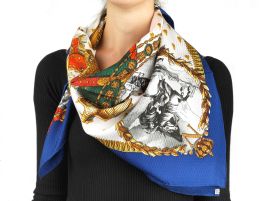HERMES CARRE FOULARD "NAPOLEON"
in seta, stampa "Napoléon" disegnata dall'artista Philippe Ledoux nel 1963, raffigurante i momenti più significativi della vita di Bonaparte, insieme ai suoi oggetti più emblematici, Hermès Paris, firmato "Ledoux".
Dim. cm 90x90
HERMES "NAPOLEON" CARRE SCARF
Questo carré riassume su un tessuto imprimé, gran parte dell'epopea napoleonica. Insieme alle api, simbolo di potere di origine egizia già usato dai merovingi, si ritrovano rappresentati i momenti più significativi della vita di Bonaparte, insieme agli oggetti che tutt'oggi più di altri lo ricordano.
Si riconoscono, a destra, l'uniforme verde dei cacciatori a cavallo, quella che gli era più cara e con la quale sarà sepolto a Sant'Elena. A sinistra, l'abito da primo console che Napoleone indosserà all'inizio di questo incarico mentre al centro, incorniciato nel collare della Legione d'Onore, vediamo l'arrivo della carrozza alla cattedrale di Notre-Dame il 2 dicembre 1804, giorno della sua autoincoronazione come imperatore dei francesi.
Agli angoli quattro medaglioni incorniciati da corone d'alloro rappresentano (a partire da quello in alto a sinistra e proseguendo la lettura in senso orario): il passaggio delle Alpi. tratto dal celibre quadro di david; Napoleone a Wagram in sella al suo cavallo arabo Aly; Napoleone che distribuisce le sciabole ai granatieri della Guardia; Napoleone ferito a Ratisbonne.
E ancora oggetti che hanno rappresentato molto per Bonaparte: le insegne portabandiera realizzate da Chander nel 1804 con l'aquila imperiale, la spada da primo console con l'elsa in avorio e oro guarnita alla sommità da due teste di leone, quella che portava quando si incoronò imperatore, in basso le due sciabole che lo hanno accompagnato nella campagna d'Egitto. infine, uno dei suoi famosi cappelli di feltro nero: questo modello è del 1807.
Si dice che Napoleone, dal 1800 al 1815, abbia commissionato almeno centoventi cappelli al suo fornitore ufficiale, il cappellaio Poupard, che fu sostituito gli ultimi due anni da un nuovo fornitore, tale Menaglier.
This carré sums up a large part of the Napoleonic epic on an imprimé fabric. Together with the bees, a symbol of power of Egyptian origin already used by the Merovingians, the most significant moments of Bonaparte's life are represented, together with the objects that still today remember him more than others.
On the right, one recognizes the green uniform of the hunters on horseback, the one that was dearest to him and with which he will be buried in Saint Helena. On the left, the first consul dress that Napoleon will wear at the beginning of this assignment while in the center, framed in the collar of the Legion of Honor, we see the arrival of the carriage at Notre-Dame cathedral on December 2, 1804, the day of his self-coronation as emperor of the French.
At the corners, four medallions framed by laurel wreaths represent (starting from the one on the top left and continuing the reading in a clockwise direction): the passage of the Alps. Taken from David's famous painting; Napoleon to Wagram riding his Arabian horse Aly; Napoleon who distributes the sabers to the grenadiers of the Guard; Napoleon wounded in Ratisbonne.
And still objects that represented a lot for Bonaparte: the flagship signs made by Chander in 1804 with the Imperial eagle, the first consul sword with the ivory and gold hilt garnished at the top by two lion heads, the one he wore when he crowned himself emperor, below the two sabers who accompanied him in the Egyptian countryside. finally, one of his famous black felt hats: this model is from 1807.
Napoleon is said to have commissioned at least one hundred and twenty hats from his official supplier, the Hatter Poupard, from 1800 to 1815, who was replaced the last two years by a new supplier, Mr Menaglier.
Bibliografia:
"Mito e Bellezza", Catalogo a cura di Roberta Martinelli e Velia Gini Bartoli, pp 70-73, Mondadori Electa S.p.A., Verona, 2009.




